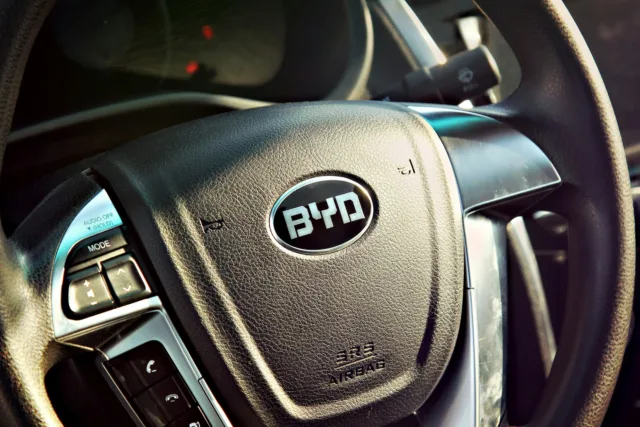
In Vijayawada, a midsize city in the southern Indian state of Andhra Pradesh, a senior manager for Chinese electric vehicle maker BYD’s local franchise partner said he is seeing a steady shift in the behavior of customers visiting the local dealership.
“Almost all the cars we sold a year ago would be the customer’s second vehicle,” the manager said, declining to be identified as he was not allowed to speak to media. “Now, most of them consider buying a BYD as their primary vehicle.”
India’s charging infrastructure remains sparse, but this shift in confidence is translating into higher sales for BYD—which has already surpassed last year’s figure—even as competition with domestic brands and other foreign EV majors intensifies in the world’s third largest automotive market.
BYD surpassed the 3,000-vehicle sales mark in early August, exceeding its total for the whole of 2024 and setting a new annual record in the Indian market. And it will likely see many more sales as the festive season, when Indians make the bulk of their major purchases, begins next month.
BYD has benefited from a “horizontal sales strategy” of expanding into small and midsize towns, said Ravi Bhatia, president of the Indian unit of consultancy Jato Dynamics. The company now has dealerships in about 34 cities and towns across the country.
But there is still plenty of room for expansion. In comparison, Indian-Chinese joint venture JSW MG Motor India had sales and service facilities in 170 cities and towns as of mid-2024, with an aim to expand to 270 cities by the middle of 2025.
The Sealion 7 SUVwas the company’s bestseller in India in the first half of 2025, data from Jato Dynamics showed, with 1,232 sold. It was followed by the seven-seater eMax 7 multipurpose vehicle, the longstanding Atto 3 SUV, and finally the Seal sedan.
The vehicles start at between IDR 2.5–4.9 million (USD 28,600–56,056) depending on the model, placing them in the mid-to-premium price range of the Indian market.
“Most of our customers are interested in the SUVs as they offer better road clearance that help navigate potholes or other issues,” the franchise manager from Andhra Pradesh said. “We see a lot of middle-aged customers go for the Atto, while younger, more performance-focused customers go for the Sealion or the Seal.”
BYD’s bump in sales is in line with a wider 61% year-on-year (YoY) jump in overall passenger EV sales in the first half of 2025, data from Jato Dynamics showed.
Within that, a 180% surge in sales for foreign EV makers has boosted the conviction of global majors like Tesla and VinFast, both of which finally entered the Indian market in July and August, respectively. The market also has considerable headroom, with EV sales making up just over 4% of total automobile sales in the first six months of 2025.
Domestic EV leaders Tata Motors and Mahindra, which together hold over half of the market, cumulatively grew 18% YoY in the same period, held back by a decline in Tata Motors sales.
Although BYD is ahead of or closing in on some of its international rivals, it faces geopolitical pressures unlike any of them, as tensions between its home nation and India remain high despite some recent indications of an improvement in relations.
Indian commerce minister Piyush Goyal said in April that the government had declined investment plans by the Chinese giant, having earlier rejected an investment proposal of USD 1 billion to build a manufacturing plant in 2023. The company has an assembly facility outside the southern Indian city of Chennai.
“Without local manufacturing, BYD incurs higher customs costs compared to rivals like VinFast, possibly gating price competitiveness,” said Harshvardhan Sharma, group head of Auto Tech and Innovation at Nomura Research Institute.
“Elevated costs may compress margins or translate into less competitive pricing, particularly critical in the value segment,” Sharma added.
VinFast, which has agreed to invest up to USD 2 billion in India and set up its first overseas plant in India’s Tamil Nadu state earlier this month, will likely see import tariffs fall as it ramps up capacity in the new plant.
BYD will have to fight the likes of Hyundai and VinFast in the mid-priced segment, while it is up against EVs from the likes of BMW and Mercedes-Benz in the lower levels of the premium segment. The European automakers have market shares of 2% and 1%, respectively.
A joint venture similar to the one between China’s SAIC and India’s JSW Group, which co-own JSW MG Motor, might be what BYD needs to eventually stave off competition, Bhatia said. The company, in which SAIC holds a 49% stake, saw EV sales roughly triple year-on-year to over 21,000 vehicles in the first half of 2025.
“When you are fighting with a Hyundai or an MG, you cannot succeed unless you get the price right,” Bhatia said.
“The market gets smaller as you go higher (up the price range), and the rich have many attractive options,” he said. “BMW, Mercedes are simply more familiar and have more brand value.”
This article first appeared on Nikkei Asia. It has been republished here as part of 36Kr’s ongoing partnership with Nikkei.









